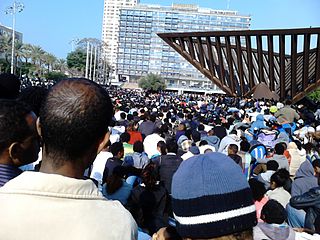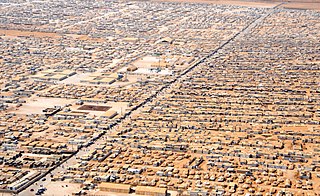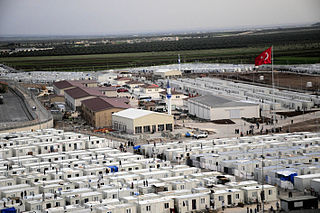
A refugee, conventionally speaking, is a person who has lost the protection of their country of origin and who cannot or is unwilling to return there due to well-founded fear of persecution. Such a person may be called an asylum seeker until granted refugee status by the contracting state or the United Nations High Commissioner for Refugees (UNHCR) if they formally make a claim for asylum.
Palestinian refugees are citizens of Mandatory Palestine, and their descendants, who fled or were expelled from their country over the course of the 1947–1949 Palestine war and the Six-Day War. Most Palestinian refugees live in or near 68 Palestinian refugee camps across Jordan, Lebanon, Syria, the West Bank and the Gaza Strip. In 2019 more than 5.6 million Palestinian refugees were registered with the United Nations.
In international law, a stateless person is someone who is "not considered as a national by any state under the operation of its law". Some stateless people are also refugees. However, not all refugees are stateless, and many people who are stateless have never crossed an international border. At the end of 2022, the United Nations High Commissioner for Refugees estimated 4.4 million people worldwide as either stateless or of undetermined nationality, 90,800 (+2%) more than at the end of 2021.
There are tens of thousands of Sudanese refugees in Egypt, most of them seeking refuge from ongoing military conflicts in their home country of Sudan. Their official status as refugees is highly disputed, and they have been subject to racial discrimination and police violence.

Refugees of Iraq are Iraqi nationals who have fled Iraq due to war or persecution. Throughout 1980 until 2017, there were a large number of refugees fleeing Iraq and settling throughout the world, peaking with the Iraq War and continued until the end of the most recent War in Iraq (2013–2017). Precipitated by a series of conflicts including the Kurdish rebellions during the Iran–Iraq War, Iraq's Invasion of Kuwait (1990) and the Gulf War (1991), the subsequent sanctions against Iraq (1991–2003), culminating in the Iraq War and the subsequent War in Iraq (2013–2017), millions were forced by insecurity to flee their homes in Iraq. Like the majority of refugees worldwide, Iraqi refugees established themselves in urban areas in other countries rather than in refugee camps. In April 2007, there was an estimate of over four million Iraqi refugees around the world, including 1.9 million in Iraq, 2 million in neighboring Middle East countries, and around 200,000 in countries outside the Middle East. The United Nations High Commissioner for Refugees (UNHCR) has led the humanitarian efforts for Iraqi refugees. The Iraqi displacement of several million was the largest in the Middle East at the time, and was even larger than the number of Palestinians who were displaced in 1948 during the creation of the state of Israel.

Syrian diaspora refers to Syrian people and their descendants who chose or were forced to emigrate from Syria and now reside in other countries as immigrants, or as refugees of the Syrian Civil War.

Palestinians in Iraq are people of Palestinians, most of whom have been residing in Iraq after they were displaced in 1948. Before 2003, there were approximately 34,000 Palestinians thought to be living in Iraq, mainly concentrated in Baghdad. However, since the 2003 Iraq War, the figure lies between 10,000–13,000, although a precise figure has been hard to determine. The situation of Palestinians in Iraq deteriorated after the fall of Saddam Hussein and particularly following the bombing of the Al-Askari Mosque in 2006. Since then, with the rise in insecurity throughout Iraq, they have been the target of expulsion, persecution and violence by Shia militants, and the new Iraqi Government with militant groups targeting them for preferential treatment they received under the Ba'ath Party rule. Currently, several hundred Palestinians from Iraq are living in border camps, after being refused entry to neighbouring Jordan and Syria. Others have been resettled to third countries.

African immigration to Israel is the international movement to Israel from Africa of people that are not natives or do not possess Israeli citizenship in order to settle or reside there. This phenomenon began in the second half of the 2000s, when a large number of people from Africa entered Israel, mainly through the then-lightly fenced border between Israel and Egypt in the Sinai Peninsula. According to the data of the Israeli Interior Ministry, 26,635 people arrived illegally in this way by July 2010, and over 55,000 by January 2012. In an attempt to curb the influx, Israel constructed the Egypt–Israel barrier. Since its completion in December 2013, the barrier has almost completely stopped the immigration of Africans into Israel across the Sinai border.
Palestinians in Lebanon include the Palestinian refugees who fled to Lebanon during the 1948 Palestine War, their descendants, the Palestinian militias which resided in Lebanon in the 1970s and 1980s, and Palestinian nationals who moved to Lebanon from countries experiencing conflict, such as Syria. There are roughly 3,000 registered Palestinians and their descendants who hold no identification cards, including refugees of the 1967 Naksa. Many Palestinians in Lebanon are refugees and their descendants, who have been barred from naturalisation, retaining stateless refugee status. However, some Palestinians, mostly Christian women, have received Lebanese citizenship, in some cases through marriage with Lebanese nationals.
Refugees of the Syrian civil war are citizens and permanent residents of Syria who have fled the country throughout the Syrian civil war. The pre-war population of the Syrian Arab Republic was estimated at 22 million (2017), including permanent residents. Of that number, the United Nations (UN) identified 13.5 million (2016) as displaced persons, requiring humanitarian assistance. Of these, since the start of the Syrian civil war in 2011 more than six million (2016) were internally displaced, and around five million (2016) had crossed into other countries, seeking asylum or placed in Syrian refugee camps worldwide. It is often described as one of the largest refugee crises in history.

Nearly half of all refugees are children, and almost one in three children living outside their country of birth is a refugee. These numbers encompass children whose refugee status has been formally confirmed, as well as children in refugee-like situations.

Syrian refugee camp and shelters are temporary settlements built to receive internally displaced people and refugees of the Syrian Civil War. Of the estimated 7 million persons displaced within Syria, only a small minority live in camps or collective shelters. Similarly, of the 8 million refugees, only about 10 percent live in refugee camps, with the vast majority living in both urban and rural areas of neighboring countries. Beside Syrians, they include Iraqis, Palestinians, Kurds, Yazidis, individuals from Somalia, and a minority of those who fled the Yemeni and Sudanese civil wars.

Palestinians in Syria are people of Palestinian origin, most of whom have been residing in Syria after they were displaced from their homeland during the 1948 Palestinian expulsion and flight. Palestinians hold most of the same rights as the Syrian population, but cannot become Syrian nationals except in rare cases. In 2011, there were 526,744 registered Palestinian refugees in Syria. Due to the Syrian Civil War, the number of registered refugees has since dropped to about 450,000 due to many Palestinians fleeing to Lebanon, Jordan or elsewhere in the region to escaping to Europe as refugees, especially to Germany and Sweden.
Syrians in Lebanon refers to the Syrian migrant workers and, more recently, to the Syrian refugees who fled to Lebanon during the Syrian Civil War. The relationship between Lebanon and Syria includes Maronite-requested aid during Lebanon's Civil War which led to a 29-year occupation of Lebanon by Syria ending in 2005. Following the outbreak of the Syrian Civil War, refugees began entering Lebanon in 2011. Lebanon's response towards the influx of refugees has been criticized as negative, with the Lebanese government leaving them undocumented and limited and attacks on Syrian refugees by Lebanese citizens which go unaddressed by authorities. Despite the strained relationship between the Syrians and Lebanese, taking into consideration only Syrian refugees, Lebanon has the highest number of refugees per capita in the world, with one refugee per four nationals. The power dynamic and position of Syria and Lebanon changed drastically in such a short amount of time, it is inevitable that sentiments and prejudices prevailed despite progressions and changes in circumstance.
Syrians in Kuwait include migrants from Syria to Kuwait, as well as their descendants. The number of Syrians in Kuwait is estimated at 161,000 estimated (2020) and are mainly "Syrian expatriates who have overstayed in Kuwait". They were granted special one year emergency permits in 2015 on the grounds that their work contracts had terminated and they were hence unable to renew their passports due to technical issues at the Syrian Embassy of Kuwait. However, from 2018, Kuwaiti authorities no longer grant leniency to Syrians from deportations. All this is in contradiction to another article in the Orient News which imply that Kuwait has never exempted Syrians from regular residency laws and that even some Syrians deported from Kuwait in 2017 were killed upon arrival in Syria.

The Partnership for Refugees is a refugee public-private partnership established in June 2016 as the Partnership for Refugees by the Obama administration to facilitate President Barack Obama's commitment to creative solutions for the refugee crisis by engaging the private sector. The Partnership, an initiative established through collaboration between the State Department and USA for UNHCR with significant support from Accenture Federal Services, was established to facilitate private sector commitments in response to President Obama's June 30, 2016 Call to Action for Private Sector Engagement on the Global Refugee Crisis. On September 20, 2016, at the Leaders Summit on Refugees at the United Nations, President Obama announced that 51 companies from across the American economy have pledged to make new, measurable and significant commitments that will have a durable impact on refugees residing in countries on the frontlines of the global refugee crisis and in countries of resettlement, like the United States.

Since the onset of the Syrian Civil War in March 2011, over 1.5 million Syrian refugees have fled to Lebanon, and constitute nearly one-fourth of the Lebanese population today. Lebanon currently holds the largest refugee population per capita in the world.

Refugees of the Syrian Civil War in Turkey are the Syrian refugees fleeing the Syrian Civil War. The Republic of Turkey hosts over 3.7 million registered refugees.
As Indonesia did not sign the convention on the status of refugees and lacks any domestic legislations providing refugees rights, refugees in Indonesia do not have the right to employment, permanent residency or citizenship.

Human rights in Suriname are currently recognised under the Constitution of the Republic of Suriname of 1987. Suriname is a constitutional democracy with a president elected by the unicameral National Assembly. The National Assembly underwent elections in 2020, electing Chan Santokhi as president. The National Assembly has a commission pertaining to issues regarding the country's human rights. The Human Rights Office of the Ministry of Justice and Police is responsible for advising the government on regional and international proceedings against the state concerning human rights. Human rights in Suriname is periodically reviewed by the United Nations Human Rights Committee (UNHRC), on which it is often believed the level of human rights do not yet meet international standards.











